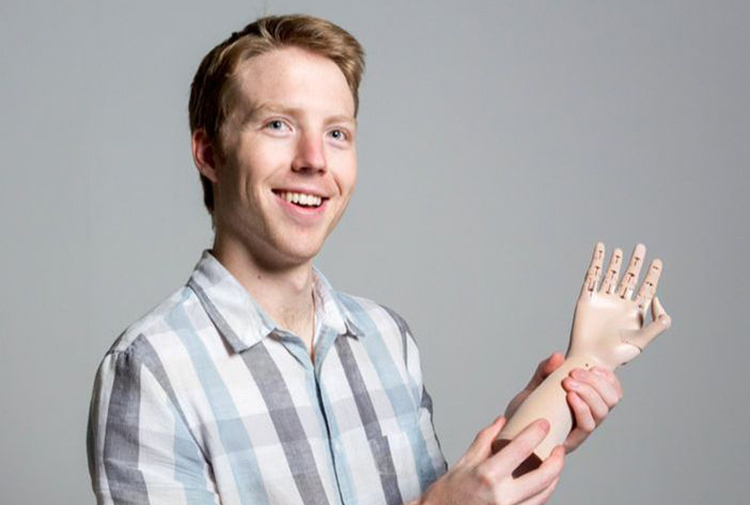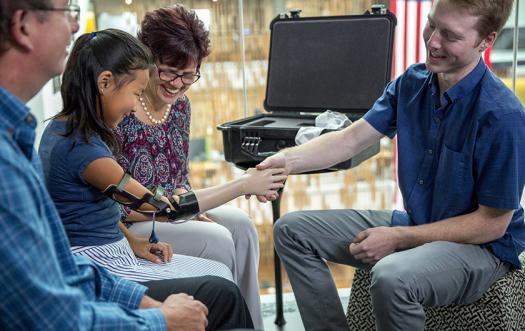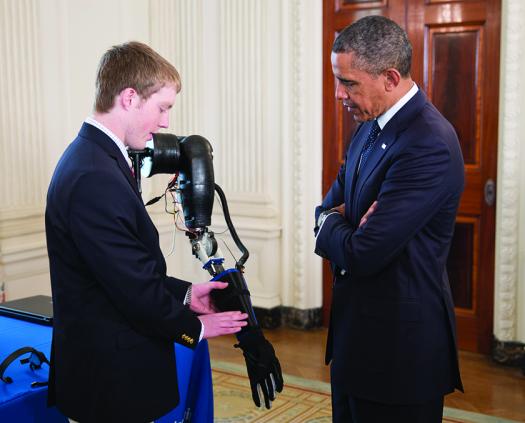This alum prints prosthetics of the future

Easton LaChappelle is the CEO and Founder of Unlimited Tomorrow, which uses low-cost 3D printing to build better, easy-to-use prosthetics. Modern prosthetics can be expensive, heavy, and hard to use, so Easton, an Intel ISEF 2012 and 2013 finalist, founded the company at 18. At 14, he made his first robotic hand out of LEGOs, fishing wire, and electrical tubing. Since then, his tech has advanced into a 3D printed, brain-powered robotic arm.
While presenting at one of his science fairs, he met a 7-year-old girl missing her right arm and wearing a simple prosthesis that cost $80,000. “This was my ah-ha moment,” Easton says. “I saw an opportunity to take what I was making for fun in my bedroom and potentially impact someone’s life!” Recently, he had the opportunity to give another little girl an improved prosthesis, with fingers that move.
Read on to learn how Easton is building the future of prosthetics.
HOW 3D PRINTING CAN MAKE PROSTHETICS MORE AFFORDABLE AND FUNCTIONAL: 3D printing is a perfect technology for prosthetics because at a high-level it’s the ability to make something customized for a fraction of the cost. Prosthetics are so expensive because there is so much manual custom labor that goes into creating just one device.
3D printing is a perfect technology for prosthetics.
3D printing can expedite this process and achieve designs that were otherwise impossible conventionally. This also allows us to create a custom device for each person and we can print many designs all at once.
Unlimited Tomorrow uses low-cost 3D scanners and computers to digitally map an amputees’ residual limb and opposite full arm, if they have one. This raw scan data goes through software that automatically places mechanical and robotic designs, based on the shapes and dimensions of the person. The output is then ready to print in a network of 3D printers around the world. This process allows us to produce some of the most advanced artificial limbs, even in remote and underprivileged communities.
I would not be where I’m at today if it wasn’t for science fairs. It made me challenge what was possible.
At Unlimited Tomorrow, I’m involved in every aspect of the company, including business development, operations, hiring, financial management, and much more. I’m also heavily involved in research and development and product design.
Society alumni are champions of science. You can become a champion of science too.

HIS CURRENT STEM GOALS: I have a lot of STEM goals! Some of them are a little far out and will require technology catching up a bit. But most of them involve making my devices more lifelike and easier to control, including mimicking human skin to provide grip and contouring to objects, incorporating wireless charging, and creating new sensors to read muscles to control the hand as if it’s your own.
HOW HE BECAME INTERESTED IN SCIENCE AND TECHNOLOGY: I’ve always loved science and technology. I remember growing up and taking apart everything I could get my hands on just because I was curious about how things worked. I was always looking for a way to take this to the next level with a project that was fun and open-ended. The idea to make a robotic hand controlled by a glove came to me when I was 14. I entered this into the science fair and I was blown away by the attention my project was getting.
Prosthetics are so expensive because there is so much manual custom labor that goes into creating just one device.
I started teaching myself programming, electronics, and mechanics from the internet by watching tutorials on YouTube, online forums, Skyping people around the world, and trial and error. I slowly started advancing my designs by using new materials and making the hand more functional. I built a full robotic arm that could shake your hand and toss a ball. I was displaying this at the state science fair in Fort Collins, Colorado when I met a 7-year-old girl who was missing her right arm. She was wearing a very simple prosthesis that cost around $80,000! This was my ah-ha moment. I saw an opportunity to take what I was making for fun in my bedroom and potentially impact someone’s life!

THE IMPORTANCE OF SCIENCE FAIRS: I would not be where I’m at today if it wasn’t for science fairs. Science fairs pushed me every year to make something better and better and provided me a platform to share my ideas and find other like-minded people. Through science fairs, I was able to present in front of engineers, scientists, and other experts who provide me with feedback. If you do well, science fairs also provide award money you can put back into your project to continue development. Every year it made me challenge what was possible. When you see everyone’s project and what they do, it makes you excited to learn and for what the future holds.
HIS ADVICE TO YOUNG PEOPLE INTERESTED IN STEM: My advice for young people in science: explore your curiosity. This is the driving force of what made me start this and to continue moving forward. In today’s world, there are vast amounts of resources at your fingertips. Use these resources to explore and find your passion. There is no excuse to not do what you love.
I taught myself programming, electronics, and mechanics from the internet, YouTube, online forums, Skyping people around the world, and trial and error.
Don’t be afraid to stray away from the “normal path.” There are so many ways in today’s world to continue learning and to do what you love. There’s a lot of things that push you on a conventional path but don’t let others decide your future. Be bold and stay curious.


